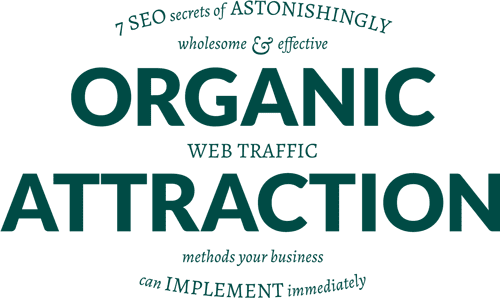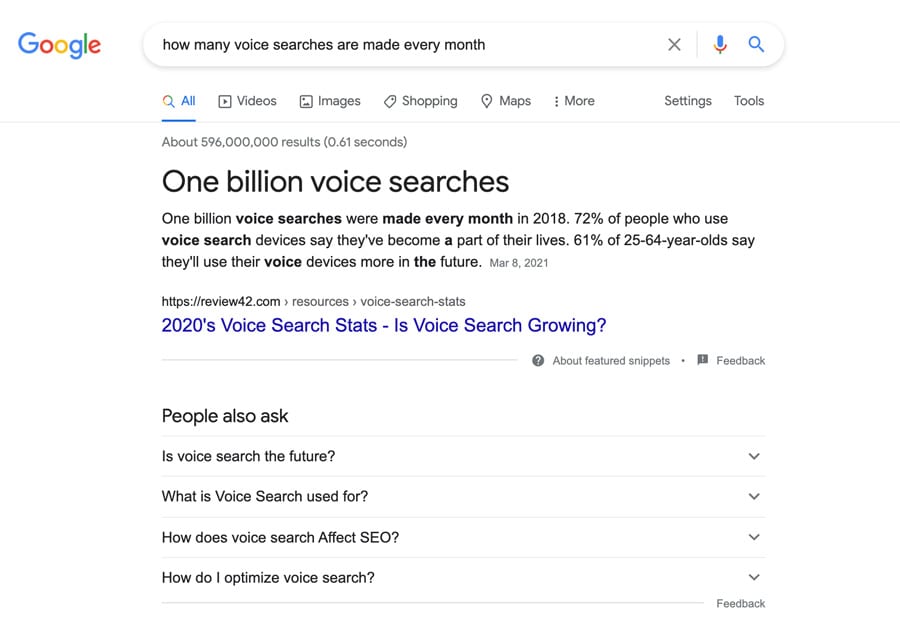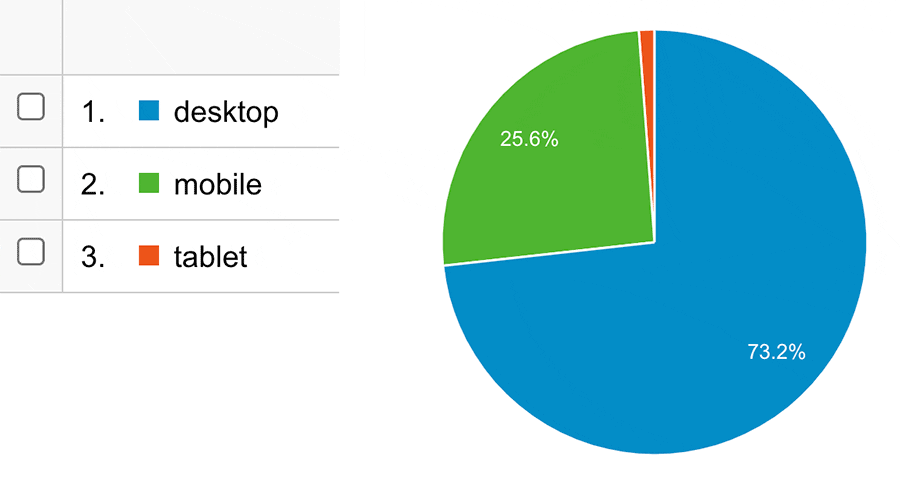Organic Attraction
7 actionable SEO insights to attract organic website traffic
approx 7 minute read
If you’re reading this, you must be interested in driving more traffic to your website.
You know people already use search engines to find businesses like yours.
You’d like to find out what you can do to help get more of those people onto your website.
Good news, you’re in the right place. We have 7 proven actionable insights for you to implement right away.
It all started with a Google
Over 90% of consumers used a search engine to find a local business in the last year.
Most online experiences already began with a search engine.
Now, even when shopping locally, the first stop is overwhelmingly your smartphone or smart speaker.
Demand for SEO is growing
Demand for SEO services has increased 4 fold since the start of the pandemic.
People’s buying behaviour has shifted even further online. It was always heading this way.
Events of the last 12 months have merely accelerated the inevitable digital uptake.
Reap what you SEO
So what can you do to boost the chances of getting your website highlighted by the search engines?
Well, it’s fair to say there’s no silver bullet.
The more sophisticated Google becomes, the more the search engines aim to reward good, honest work.
And that’s great news. Because it means that you have actionable insights at your fingertips to help you authentically climb page rankings in record time.
We’ve handpicked our 7 top strategies to help spring clean your SEO efforts in 2021.
#1 Page experience
Google now has the skills to pay waaaay more attention to user behaviour and this is the year they’re going all out.
So what are they looking for?
Well, a search engine’s job is to recommend the most appropriate site for the user’s query.
So the key is to understand what the person is looking for help with.
Answer this generously, with valuable and unique content.
How someone interacts with a page, their dwell time, and engagement level, can raise an eyebrow.
A mental note is made when someone clicks ‘back’ and the AI makes a note of how quickly that happened.
Great content encourages people to stay a while. It’s also important you fix those broken links.
Make your site look good, feel snappy, and behave as expected.
All in aid of delivering a flawless on-page experience aligned with user intent.
Slick, snappy, happy. Be the last click.
Nettl Nugget
Put yourself in your customer’s shoes. Compare your content against other websites that rank for the search terms you’re targeting.
#2 Schema markup
Schema markup is like annotating your web page with comments (markup) explaining what each bit is about.
It’s like having helpful little sticky notes about the place.
This technical stuff isn’t always obvious on the page.
It works behind the scenes. It structures and highlights the content.
This helps search engines display content the right way (often rewarding it with a very prominent position on the results page).
But it’s not just about featured snippets.
We’re talking about marking up all aspects of your page technically and correctly.
This includes links, citation, lazyload content etc. And more recently ‘Passages’.
Passages help Google differentiate between different sections of content on your website.
Think little chapters or mini-stories, that hold SEO credentials in their own right.
Thoughtful structure such as this helps real brains and rank brains alike.
Nettl Nugget
Use structured data to frame the content on your page. Watch our free webinar on Schema Markup to dive into the detail.
#3 Useful content
We’re talking quality AND quantity here.
They say size isn’t everything. But the fact is, longer articles tend to perform better than shorter ones for search queries.
That’s because Google assumes, usually rather accurately, the longer article is more helpful to the user.
But no rambling for the sake of it, or spammy superfluous text that doesn’t make sense.
Make it your goal to match user intent.
Go into detail and depth whilst remaining sensitive to your audience (Basically, no technical jargon unless it’s a technical piece aimed at industry peers).
Break the content up and structure effectively to make it human and bot friendly.
Remember, Google now use ‘Passages’ to divide up a particular page into sections of very specific content. Make use of that.
Nettl Nugget
Write for humans, not bots. Break text up into bitesize sections. Style the page for skim readers by using headers and emphasising words. Use ‘top takeaways’ so people can learn the key messages without having to read the whole article.
#4 Voice search
“Hey Google, how many voice searches are made every month?”
“One billion”
OK, so that’s significant. It’s hard to put a finger on exactly how many searches are made using a voice command but it’s estimated to be around 50%.
Even Google themselves said 20% of mobile queries were voice searches… And that was in 2016 – A digital lifetime ago.
With a Hubspot survey showing 74% of respondents used voice search in the last month, it’s fair to say it’s not just dentists using it.
Optimising content for voice search snuggles up nicely with targeting long-tail keywords as people don’t tend to abbreviate in the same way they do when typing.
Their queries are longer and more conversational.
So your content should reflect this, literally, by having a conversation back with them.
Target ‘question keywords’ in your content.
Optimise your content for featured snippets. Google tends to read these out.
Nettl Nugget
A great way to tackle this, while ticking a lot of user-focused boxes, is to create a FAQ section.
#5 Mobile-first
Mobile friendly is so 2015.
And yet it’s surprising just how many websites still aren’t optimised for a handheld experience.
Since 2019 Google have adopted a mobile-first approach.
Meaning they predominantly look at the mobile version of a website as opposed to the desktop one.
This comes as no surprise, given “Nearly three-quarters of the world will use just their smartphones to access the internet by 2025″.
Plus, visual search (using apps like Google Lens) is growing in popularity.
Studies show a correlation between the results suggested by visual search and how the site performs on a mobile search.
It’s no longer just about responsive websites. That’s just the start.
Does the content load quickly. How easy is it to use?
There is already a lot of noise about ‘Core Web Vitals‘.
Core Web Vitals is Google’s way of putting numbers against perceived user experience.
One of those metrics, Cumulative Layout Shift (or CLS), measures how ‘jumpy’ things can be when the page first loads.
Like when the text shifts about or a menu item moves when you press it.
Have you ever ended up clicking something else entirely and having to go back? Not good.
The message here is your website needs to look, feel, and work flawlessly on a handheld device.
That’s if you want search engines to send people there.
Nettl Nugget
When designing your website, think mobile-first. Google is.
Start by planning out how it should look on a handheld device.
The desktop experience comes second
(*Unless your Google Analytics device stats prove otherwise – See example below).
Think mobile-first…
*Unless your mobile usage analytics prove otherwise!
Above are our device usage statistics for this month.
As you can see, three-quarters of the traffic viewed our website on ‘desktop’.
This is most likely because we operate in a B2B market. So we buck the global web traffic trend.
The majority of folk searching for our products and services are doing so while at work, on their ‘desktop’ computers. (Albeit 45% are on laptop devices).
Also, less people are ‘out and about’ at the moment.
The key takeaway here is to check and keep an eye on it. Do what’s best for you and your audience.
#6 Image optimisation
Typically so much low hanging fruit in the image optimisation arena.
This is especially if your site has good content but you’ve not begun optimising for search yet.
Google doesn’t ‘see’ the images like you and I do.
At least, it’s not mainstream. Not yet.
Image understanding and object recognition are still work in progress.
So until that day, what do we do?
Just like with other aspects of SEO, we give search engines a helping hand.
We assist them to make sense of our content.
We label things. And there is a lot of scope to do this.
Not just alt tags (words that describe the image), but the image title is important too.
Loading speed is such a behemoth of a ranking factor these days.
Metrics such as image size, image proportions, image delivery and storage come into play.
Some websites, justifiably so, are very image (and video) heavy.
But can you honestly say you’re doing everything possible to optimise this content for efficiency?
Nettl Nugget
Use a free service such as TinyPNG to decrease your image sizes before uploading them to your website.
#7 Citations
Authority used to basically come down to backlinks. A show of hands. Not anymore.
Now authority, credibility, is more about the EAT principle (Expertise, Authority, and Trustworthiness).
This is critically important in YMYL (Your Money, Your Life).
So, stuff to do with health and finance especially.
But recent major algorithm changes have demonstrated how these benchmark criteria were applied globally to evaluate all websites.
Think of it as content quality control.
So are backlinks dead? No.
But more sophisticated ranking intelligence means they matter much less.
The sheer amount of links is a very binary metric in comparison.
Sure, links still count for something.
Don’t forget, they could deliver significant traffic singlehandedly.
But intricate calculations of authority, authenticity and sentiment bring link juice into a world of technicolor.
Boost your credibility by giving talks, in real life, or webinars and podcasts.
Create resources (like research and visuals) that people in the industry can use and link back to.
Get cited. Get mentioned for good things on industry blogs, news articles and listings.
Signals about how ‘credible’ you are will come from what others are saying about you.
As opposed to how good you say you are.
Google value that more. They don’t even have to be links, just bonafide positive association.
Nettl Nugget
Have a bio ready and apply it consistently across the web. Are you a ‘renowned expert tree whisperer with over 30 years experience’? Then say so. This makes it easy for people who reference you to copy and paste.
When shall we start?
Fact is, there’s only one way to climb search engine rankings.
And that’s sleeves rolled up, elbows out.
You can’t just stick up a website and hope people will find you.
It takes investment, skill and effort. It’s hard.
That’s why there’s strong demand for search engine optimisation.
Done right, it’s a powerful way to get new visitors.
Done badly, it’s damaging. Like a perm.
You could do it yourself.
We have a tonne of free SEO guides to get you started. Or, we could do it together.
You can focus on the customer service, knowledge, insight and passion that is so influential.
Let our centralised Nettl SEO team take care of the geeky and time-consuming, hard technical bits.
Don’t SEO alone. Find your local studio.














